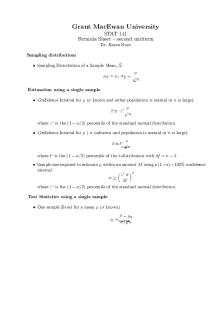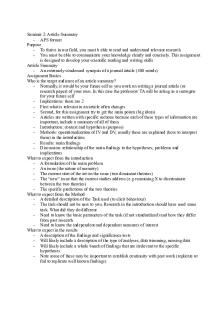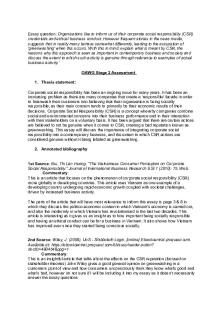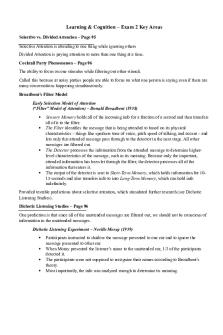ORF309 - Lecture notes 2 PDF

| Title | ORF309 - Lecture notes 2 |
|---|---|
| Author | Anonymous User |
| Course | Finance |
| Institution | Harvard University |
| Pages | 202 |
| File Size | 3.4 MB |
| File Type | |
| Total Downloads | 7 |
| Total Views | 146 |
Summary
fdsa...
Description
Ramon van Handel
Probability and Random Processes ORF 309/MAT 380 Lecture Notes Princeton University
This version: February 22, 2016
Preface
These lecture notes are intended for a one-semester undergraduate course in applied probability. Such a course has been taught at Princeton for many years by Erhan Çinlar. The choice of material in these notes was greatly inspired by Çinlar’s course, though my own biases regarding the material and presentation are inevitably reflected in the present incarnation. As always, some choices had to be made regarding what to present: •
It should be emphasized that this course is not intended for a pure mathematics audience, for whom an entirely different approach would be indicated. The course is taken by a diverse range of undergraduates in the sciences, engineering, and applied mathematics. For this reason, the focus is on probabilistic intuition rather than rigorous proofs, and the choice of material emphasizes exact computations rather than inequalities or asymptotics. The main aim is to introduce an applied audience to a range of basic probabilistic notions and to quantitative probabilistic reasoning.
•
A principle I have tried to follow as much as possible is not to introduce any concept out of the blue, but rather to have a natural progression of topics. For example, every new distribution that is encountered is derived naturally from a probabilistic model, rather than being defined abstractly. My hope is that this helps students develop a feeling for the big picture and for the connections between the different topics.
•
The range of topics is quite large for a first course on probability, and the pace is rapid. The main missing topic is an introduction to martingales; I hope to add a chapter on this at the end at some point in the future.
It is a fact of life that lecture notes are a perpetual construction zone. Surely errors remain to be fixed and presentation remains to be improved. Many thanks are due to all students who provided me with corrections in the past, and I will be grateful to continue to receive such feedback in the future. Princeton, January 2016
Contents
0
Introduction . . . . . . . . . . . . . . . . . . . . . . . . . . . . . . . . . . . . . . . . . . . . . . . 1 0.1 What is probability? . . . . . . . . . . . . . . . . . . . . . . . . . . . . . . . . . . . . . 1 0.2 Why do we need a mathematical theory? . . . . . . . . . . . . . . . . . . . 2 0.3 This course . . . . . . . . . . . . . . . . . . . . . . . . . . . . . . . . . . . . . . . . . . . . . 4
1
Basic Principles of Probability . . . . . . . . . . . . . . . . . . . . . . . . . . . . . 5 1.1 Sample space . . . . . . . . . . . . . . . . . . . . . . . . . . . . . . . . . . . . . . . . . . . 5 1.2 Events . . . . . . . . . . . . . . . . . . . . . . . . . . . . . . . . . . . . . . . . . . . . . . . . . 6 1.3 Probability measure . . . . . . . . . . . . . . . . . . . . . . . . . . . . . . . . . . . . . 9 1.4 Probabilistic modelling . . . . . . . . . . . . . . . . . . . . . . . . . . . . . . . . . . . 12 1.5 Conditional probability . . . . . . . . . . . . . . . . . . . . . . . . . . . . . . . . . . . 16 1.6 Independent events . . . . . . . . . . . . . . . . . . . . . . . . . . . . . . . . . . . . . . 19 1.7 Random variables . . . . . . . . . . . . . . . . . . . . . . . . . . . . . . . . . . . . . . . 23 1.8 Expectation and distributions . . . . . . . . . . . . . . . . . . . . . . . . . . . . . 26 1.9 Independence and conditioning . . . . . . . . . . . . . . . . . . . . . . . . . . . . 31
2
Bernoulli Processes . . . . . . . . . . . . . . . . . . . . . . . . . . . . . . . . . . . . . . . . 37 2.1 Counting successes and binomial distribution . . . . . . . . . . . . . . . 37 2.2 Arrival times and geometric distribution . . . . . . . . . . . . . . . . . . . . 42 2.3 The law of large numbers . . . . . . . . . . . . . . . . . . . . . . . . . . . . . . . . . 47 2.4 From discrete to continuous arrivals . . . . . . . . . . . . . . . . . . . . . . . . 56
3
Continuous Random Variables . . . . . . . . . . . . . . . . . . . . . . . . . . . . . 63 3.1 Expectation and integrals . . . . . . . . . . . . . . . . . . . . . . . . . . . . . . . . 63 3.2 Joint and conditional densities . . . . . . . . . . . . . . . . . . . . . . . . . . . . 70 3.3 Independence . . . . . . . . . . . . . . . . . . . . . . . . . . . . . . . . . . . . . . . . . . . 74
4
Lifetimes and Reliability . . . . . . . . . . . . . . . . . . . . . . . . . . . . . . . . . . . 77 4.1 Lifetimes . . . . . . . . . . . . . . . . . . . . . . . . . . . . . . . . . . . . . . . . . . . . . . . 77 4.2 Minima and maxima . . . . . . . . . . . . . . . . . . . . . . . . . . . . . . . . . . . . . 80 4.3 * Reliability . . . . . . . . . . . . . . . . . . . . . . . . . . . . . . . . . . . . . . . . . . . . 85
X
Contents
4.4 * A random process perspective . . . . . . . . . . . . . . . . . . . . . . . . . . . 89 5
Poisson Processes . . . . . . . . . . . . . . . . . . . . . . . . . . . . . . . . . . . . . . . . . . 97 5.1 Counting processes and Poisson processes . . . . . . . . . . . . . . . . . . . 97 5.2 Superposition and thinning . . . . . . . . . . . . . . . . . . . . . . . . . . . . . . . 102 5.3 Nonhomogeneous Poisson processes . . . . . . . . . . . . . . . . . . . . . . . . 110
6
Random Walks . . . . . . . . . . . . . . . . . . . . . . . . . . . . . . . . . . . . . . . . . . . . 115 6.1 What is a random walk? . . . . . . . . . . . . . . . . . . . . . . . . . . . . . . . . . 115 6.2 Hitting times . . . . . . . . . . . . . . . . . . . . . . . . . . . . . . . . . . . . . . . . . . . 117 6.3 Gambler’s ruin . . . . . . . . . . . . . . . . . . . . . . . . . . . . . . . . . . . . . . . . . . 124 6.4 Biased random walks . . . . . . . . . . . . . . . . . . . . . . . . . . . . . . . . . . . . 127
7
Brownian Motion . . . . . . . . . . . . . . . . . . . . . . . . . . . . . . . . . . . . . . . . . . 135 7.1 The continuous time limit of a random walk . . . . . . . . . . . . . . . . 135 7.2 Brownian motion and Gaussian distribution . . . . . . . . . . . . . . . . 138 7.3 The central limit theorem . . . . . . . . . . . . . . . . . . . . . . . . . . . . . . . . 144 7.4 Jointly Gaussian variables . . . . . . . . . . . . . . . . . . . . . . . . . . . . . . . . 151 7.5 Sample paths of Brownian motion . . . . . . . . . . . . . . . . . . . . . . . . . 155
8
Branching Processes . . . . . . . . . . . . . . . . . . . . . . . . . . . . . . . . . . . . . . . 161 8.1 The Galton-Watson process . . . . . . . . . . . . . . . . . . . . . . . . . . . . . . . 161 8.2 Extinction probability . . . . . . . . . . . . . . . . . . . . . . . . . . . . . . . . . . . . 163
9
Markov Chains . . . . . . . . . . . . . . . . . . . . . . . . . . . . . . . . . . . . . . . . . . . . 169 9.1 Markov chains and transition probabilities . . . . . . . . . . . . . . . . . . 169 9.2 Classification of states . . . . . . . . . . . . . . . . . . . . . . . . . . . . . . . . . . . 175 9.3 First step analysis . . . . . . . . . . . . . . . . . . . . . . . . . . . . . . . . . . . . . . . 180 9.4 Steady-state behavior . . . . . . . . . . . . . . . . . . . . . . . . . . . . . . . . . . . . 183 9.5 The law of large numbers revisited . . . . . . . . . . . . . . . . . . . . . . . . . 191
0 Introduction
0.1 What is probability? Most simply stated, probability is the study of randomness. Randomness is of course everywhere around us—this statement surely needs no justification! One of the remarkable aspects of this subject is that it touches almost every area of the natural sciences, engineering, social sciences, and even pure mathematics. The following random examples are only a drop in the bucket. •
Physics: quantities such as temperature and pressure arise as a direct consequence of the random motion of atoms and molecules. Quantum mechanics tells us that the world is random at an even more basic level.
•
Biology and medicine: random mutations are the key driving force behind evolution, which has led to the amazing diversity of life that we see today. Random models are essential in understanding the spread of disease, both in a population (epidemics) or in the human body (cancer).
•
Chemistry: chemical reactions happen when molecules randomly meet. Random models of chemical kinetics are particularly important in systems with very low concentrations, such as biochemical reactions in a single cell.
•
Electrical engineering: noise is the universal bane of accurate transmission of information. The effect of random noise must be well understood in order to design reliable communication protocols that you use on a daily basis in your cell phones. The modelling of data, such as English text, using random models is a key ingredient in many data compression schemes.
•
Computer science: randomness is an important resource in the design of algorithms. In many situations, randomized algorithms provide the best known methods to solve hard problems.
•
Civil engineering: the design of buildings and structures that can reliably withstand unpredictable effects, such as vibrations, variable rainfall and wind, etc., requires one to take randomness into account.
2
0 Introduction
•
Finance and economics: stock and bond prices are inherently unpredictable; as such, random models form the basis for almost all work in the financial industry. The modelling of randomly occurring rare events forms the basis for all insurance policies, and for risk management in banks.
•
Sociology: random models provide basic understanding of the formation of social networks and of the nature of voting schemes, and form the basis for principled methodology for surveys and other data collection methods.
•
Statistics and machine learning: random models form the foundation for almost all of data science. The random nature of data must be well understood in order to draw reliable conclusions from large data sets.
•
Pure mathematics: probability theory is a mathematical field in its own right, but is also widely used in many problems throughout pure mathematics in areas such as combinatorics, analysis, and number theory.
•
. . . (insert your favorite subject here)
As a probabilist1 , I find it fascinating that the same basic principles lie at the heart of such a diverse list of interesting phenomena: probability theory is the foundation that ties all these and innumerable other areas together. This should already be enough motivation in its own right to convince you (in case you were not already convinced) that we are on to an exciting topic. Before we can have a meaningful discussion, we should at least have a basic idea of what randomness means. Let us first consider the opposite notion. Suppose I throw a ball many times at exactly the same angle and speed and under exactly the same conditions. Every time we run this experiment, the ball will land in exactly the same place: we can predict exactly what is going to happen. This is an example of a deterministic system. Randomness is the opposite of determinism: a random phenomenon is one that can yield different outcomes in repeated experiments, even if we use exactly the same conditions in each experiment. For example, if we flip a coin, we know in advance that it will either come up heads or tails, but we cannot predict before any given experiment which of these outcomes will occur. Our challenge is to develop a framework to reason precisely about random phenomena.
0.2 Why do we need a mathematical theory? It is not at all obvious at first sight that it is possible to develop a rigorous theory of probability: how can one make precise predictions about a phenomenon whose behavior is inherently unpredictable? This philosophical hurdle hampered the development of probability theory for many centuries. 1
Official definition from the Oxford English Dictionary: “probabilist, n. An expert or specialist in the mathematical theory of probability.”
0.2 Why do we need a mathematical theory?
3
To illustrate the pitfalls of an intuitive approach to probability, let us consider a seemingly plausible definition. You probably think of the probability that an event E happens as the fraction of outcomes in which E occurs (this is not entirely unreasonable). We could posit this as a tentative definition Probability of E =
Number of outcomes where E occurs . Number of all possible outcomes
This sort of intuitive definition may look at first sight like it matches your experience. However, it is totally meaningless: we can easily use it to come to entirely different conclusions. Example 0.2.1. Suppose that we flip two coins. What is the probability that we obtain one heads (H ) and one tails (T )? •
Solution 1: The possible outcomes are HH, H T, T H, T T . The outcomes where we have one heads and one tails are HT, T H. Hence, Probability of one heads and one tails =
•
2 1 = . 2 4
Solution 2: The possible outcomes are two heads, one heads and one tails, two tails. Only one of these outcomes has one heads and one tails. Hence, Probability of one heads and one tails =
1 . 3
Now, you may come up with various objections to one or the other of these solutions. But the fact of the matter is that both of these solutions are perfectly reasonable interpretations of the “intuitive” attempt at a definition of probability given above. (While our modern understanding of probability corresponds to Solution 1, the eminent mathematician and physicist d’Alembert forcefully argued for Solution 2 in the 1750s in his famous encyclopedia). We therefore immediately see that an intuitive approach to probability is not adequate. In order to reason reliably about random phenomena, it is essential to develop a rigorous mathematical foundation that leaves no room for ambiguous interpretation. This is the goal of probability theory: Probability theory is the mathematical study of random phenomena. It took many centuries to develop such a theory. The first steps in this direction have their origin in a popular pastime of the 17th century: gambling (I suppose it is still popular). A French writer, Chevalier de Méré, wanted to know how to bet in the following game. A pair of dice is thrown 24 times; should one bet on the occurence of at least one double six? An intuitive computation led him to believe that betting on this outcome is favorable, but repeated “experiments” led him to the opposite conclusion. De Méré decided to consult his friend, the famous mathematician Blaise Pascal, who started corresponding about this problem with another famous mathematician, Pierre de Fermat.
4
0 Introduction
This correspondence marked the first serious attempt at understanding probabilities mathematically, and led to important works by Christiaan Huygens, Jacob Bernoulli, Abraham de Moivre, and Pierre-Simon de Laplace in the next two centuries. It was only in 1933, however, that a truly satisfactory mathematical foundation to probability theory was developed by the eminent Russian mathematician Andrey Kolmogorov. With this solid foundation in place, the door was finally open to the systematic development of probability theory and its applications. It is Kolmogorov’s theory that is used universally today, and this will also be the starting point for our course.
0.3 This course In the following chapter, we are going to develop the basic mathematical principles of probability. This solid mathematical foundation will allow us to systematically build ever more complex random models, and to analyze the behavior of such models, without running any risk of the type of ambiguous conclusions that we saw in the example above. With precision comes necessarily a bit of abstraction, but this is nothing to worry about: the basic principles of probability are little more than “common sense” properly formulated in mathematical language. In the end, the success of Kolmogorov’s theory is due to the fact that it genuinely captures our real-world observations about randomness. Once we are comfortable with the basic framework of probability theory, we will start developing increasingly sophisticated models of random phenomena. We will pay particular attention to models of random processes where the randomness develops over time. The notion of time is intimately related with randomness: one can argue that the future is random, but the past is not. Indeed, we already know what happened in the past, and thus it is perfectly predictable; on the other hand, we typically cannot predict what will happen in the future, and thus the future is random. While this idea might seem somewhat philosophical now, it will lead us to notions such as random walks, branching processes, Poisson processes, Brownian motion, and Markov chains, which form the basis for many complex models that are used in numerous applications. At the end of the course, you might want to look back at the humble point at which we started. I hope you will find yourself convinced that a mathematical theory of probability is worth the effort. · · · This course is aimed at a broad audience and is not a theorem-proof style course.2 That does not mean, however, that this course does not require rigorous thinking. The goal of this course is to teach you how to reason precisely about randomness and, most importantly of all, how to think probabilistically. 2
Students seeking a mathematician’s approach to probability should take ORF 526.
1 Basic Principles of Probability
The goal of this chapter is to introduce the basic ingredients of a mathematical theory of probability that will form the basis for all further developments. As was emphasized in the introduction, these ingredients are little more than “common sense” expressed in mathematical form. You will quickly become comfortable with this basic machinery as we start using it in the sequel.
1.1 Sample space A random experiment is an experiment whose outcome cannot be predicted before the experiment is performed. We do, however, know in advance what outcomes are possible in the experiment. For example, if you flip a coin, you know it will come up either heads or tails; you just do not know which of these outcomes will actually occur in a given experiment. The first ingredient of any probability model is the specification of all possible outcomes of a random experiment.
Definition 1.1.1. The sample space Ω is the set of all possible outcomes of a random experiment.
Example 1.1.2 (Two dice). Consider the random experiment of throwing one red die and one blue die. We denote by (i, j) the outcome that the red die comes up i and the blue die comes up j. Hence, we define the sample space Ω = {(i, j ) : 1 ≤ i, j ≤ 6}. In this experiment, there are only 62 = 36 possible outcomes.
6
1 Basic Principles of Probability
Example 1.1.3 (Waiting for the bus). Consider the random experiment of waiting for a bus that will arrive at a random time in the future. In this case, the outcome of the experiment can be any real number t ≥ 0 (t = 0 means the bus comes immediately, t = 1.5 means the bus comes after 1.5 hours, etc.) We can therefore define the sample space Ω = [0, +∞[. In this experiment, there are infinitely many possible outcomes. Example 1.1.4 (Flight of the bumblebee). A bee is buzzing around, and we track its flight trajectory for 5 seconds. What possible outcomes are there in such a random experiment? A flight path of th...
Similar Free PDFs

ORF309 - Lecture notes 2
- 202 Pages

Lecture notes, lecture 2
- 3 Pages

2 - Lecture notes 2
- 5 Pages

Lecture notes, lecture Chapter 2
- 11 Pages

Lecture notes, lecture formula 2
- 1 Pages

2 Biodiversity - Lecture notes 2
- 33 Pages

Chapter 2 - Lecture notes 2
- 30 Pages

Blaw 2 - Lecture notes 2
- 4 Pages

Chapter 2 - Lecture notes 2
- 4 Pages

Seminar 2 - Lecture notes 2
- 2 Pages

Stage 2 - Lecture notes 2
- 3 Pages

Exam 2 - Lecture notes 2
- 5 Pages
Popular Institutions
- Tinajero National High School - Annex
- Politeknik Caltex Riau
- Yokohama City University
- SGT University
- University of Al-Qadisiyah
- Divine Word College of Vigan
- Techniek College Rotterdam
- Universidade de Santiago
- Universiti Teknologi MARA Cawangan Johor Kampus Pasir Gudang
- Poltekkes Kemenkes Yogyakarta
- Baguio City National High School
- Colegio san marcos
- preparatoria uno
- Centro de Bachillerato Tecnológico Industrial y de Servicios No. 107
- Dalian Maritime University
- Quang Trung Secondary School
- Colegio Tecnológico en Informática
- Corporación Regional de Educación Superior
- Grupo CEDVA
- Dar Al Uloom University
- Centro de Estudios Preuniversitarios de la Universidad Nacional de Ingeniería
- 上智大学
- Aakash International School, Nuna Majara
- San Felipe Neri Catholic School
- Kang Chiao International School - New Taipei City
- Misamis Occidental National High School
- Institución Educativa Escuela Normal Juan Ladrilleros
- Kolehiyo ng Pantukan
- Batanes State College
- Instituto Continental
- Sekolah Menengah Kejuruan Kesehatan Kaltara (Tarakan)
- Colegio de La Inmaculada Concepcion - Cebu



